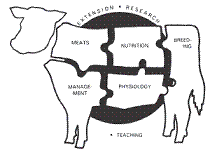Animal Science, Department of

Nebraska Beef Cattle Reports
Date of this Version
2019
Citation
2019 Nebraska Beef Cattle Report
Abstract
May-born steers were backgrounded to achieve either a high or low rate of gain. The high rate of gain was achieved by offering steers meadow hay ad libitum and 4 lb/d of a 33% CP (DM) supplement, while the low rate of gain consisted of steers grazing meadow and offered 1 lb/d of the same supplement. After backgrounding, one-half of the steers from each group entered the feedlot in May as short-yearlings, while the remainder grazed upland range until entering the feedlot as long-yearlings in mid-September. Hot carcass weight was greater for steers backgrounded to achieve a high rate of gain, but they also consumed more during the feedlot phase and had fewer carcasses grade USDA average Choice or greater compared with steers backgrounded to achieve a low rate of gain. Long-yearling steers had increased marbling scores and percentage of carcasses grading USDA average Choice or greater compared with short-yearling steers. Furthermore, long-yearlings had increased carcass weight and risk for overweight carcasses.
Included in
Large or Food Animal and Equine Medicine Commons, Meat Science Commons, Veterinary Preventive Medicine, Epidemiology, and Public Health Commons


Comments
Copyright © The Board Regents of the University of Nebraska.